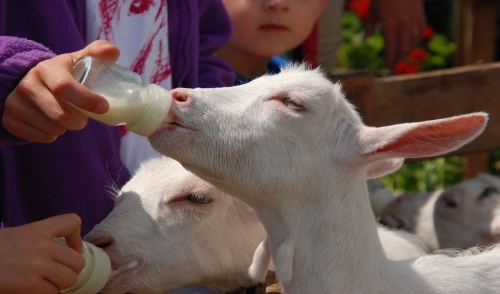{article.name}
Stay Informed
Tips on Bottle Feeding Calves, Lambs and Goats

- Share this:
- Share on Facebook
- Pin on Pinterest
- Tweet on Twitter
No matter what type of livestock you raise, bottle feeding hungry youngsters is occasionally necessary. It doesn't have to be a hassle, however, and there are many ways to make bottle feeding calves, lambs and goats easy and enjoyable for both you and the animals.
Why Bottle Feed?
While regular nursing will be best for your livestock, there are several instances where the extra work and effort of bottle feeding is desirable. Young calves, lambs and goats may be orphaned when the mother dies in a difficult birth or from post-partum infections, or a female may lack nursing or mothering instincts and could reject her offspring. Some breeders prefer the bonding experience they can have by bottle feeding livestock, especially if the animals are destined to be around for years, such as a working ox team or animals that will be used for wool or milk rather than raised for meat. Bottle feeding livestock can also be a great project for kids, as part of 4H or scouting work or even for a science fair or other school project.
By bottle feeding young livestock, it is easier to ensure each animal receives the proper nutrition critical in those first few hours and days of life, especially the rich colostrum filled with essential antibodies. If an animal naturally nurses it will receive that nourishment, but if bottle feeding is the alternative, the animal's weight, health and nutritional intake can be more closely monitored to help it grow strong and thrive along with its naturally-nursing peers.
Tips for Bottle Feeding Livestock
While different types of nursing livestock have different needs, these basic tips can help you be sure you are feeding any hungry animals appropriately.
- Always use species-appropriate nipples for each bottle. The size and shape of animals' mouths vary, as well as their sucking actions. The right nipple will feel more comfortable to the animal and will help them nurse more easily. Check that the opening is clear and does not stick, and hold the bottle at the right angle for the animal to nurse best.
- Opt for the right milk replacer to offer the proper nutrition. Different animals have different dietary needs, especially when very young. Choosing a milk replacement formula specially geared toward the animal's needs will help give it the proper nourishment for strong, healthy growth even without natural mother's milk.
- Warm the milk replacer before each feeding. Baby animals will nurse most easily when the milk is close to the body temperature of their mother, but it should not be so hot that it can cause burns to sensitive young mouths. Warm formula will also be more palatable and will flow more easily for good nursing.
- Feed young animals the proper amount and frequency for their nutritional needs. The exact amount of formula they need through bottle feeding will depend on the animal's species, weight, general health and whether or not the feeding is their only nutrition or is supplemental to weak nursing. Local climate and temperatures can also affect the amount of food needed to ensure the animal has enough calories to maintain adequate body heat.
- Keep all bottle feeding equipment clean, and sterilize bottles, nipples and other tools after each feeding. This is essential even if the gear is only used to bottle feed a single animal, as young nursing animals are especially vulnerable to bacteria and infections from dirty tools.
- Be firm but gentle when bottle feeding animals, especially as they get stronger and more insistent with head butting, pushing and other behaviors. Correct them consistently to prevent these behaviors from developing into problems that will be difficult to solve as the animals grow. Do not, however, overreact to their instinctive behaviors, or you risk creating a sense of fear associated with bottle feeding that can lead to undereating.
- If you must bottle feed several animals, consider a multi-station feeding trough or similar feeding "bar" with several nipples. This can be a faster, more efficient way to bottle feed a number of animals once they are nursing well and no longer need as much individual encouragement to eat.
- Provide good socialization for the animal outside of feeding time. While baby calves, lambs and goats are adorable and may seem like members of a human family, they need to learn to be proper animals and to get along with their species herd. Allow them to socialize with other animals whenever possible so they can learn to use their native instincts more appropriately.
Bottle feeding livestock can be a very rewarding and enriching experience as you help an animal go from a weak, hungry newborn to a fat, bouncing toddler. By taking the proper steps to bottle feed calves, lambs and goats appropriately, every newborn can have a good chance for that happy youth.
Special Offers
We are constantly adding new specials to our site. Be sure to check back often!

Comments